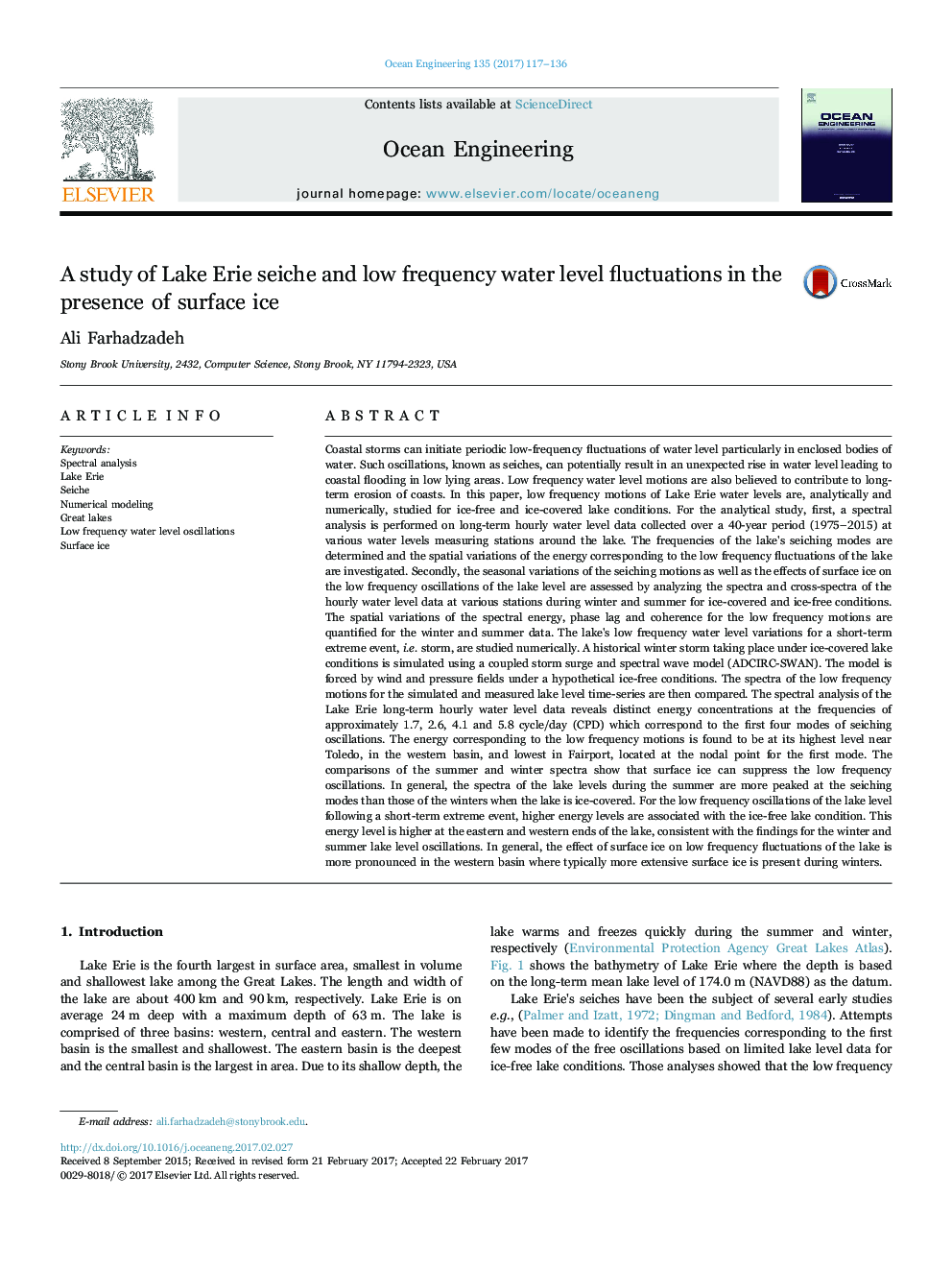| کد مقاله | کد نشریه | سال انتشار | مقاله انگلیسی | نسخه تمام متن |
|---|---|---|---|---|
| 5474562 | 1520655 | 2017 | 20 صفحه PDF | دانلود رایگان |
عنوان انگلیسی مقاله ISI
A study of Lake Erie seiche and low frequency water level fluctuations in the presence of surface ice
ترجمه فارسی عنوان
مطالعه ی نوسانات سطح آب دریاچه ی اردی و در حضور یخ سطحی
دانلود مقاله + سفارش ترجمه
دانلود مقاله ISI انگلیسی
رایگان برای ایرانیان
کلمات کلیدی
تجزیه طیفی، دریاچه اری، سایشی مدل سازی عددی، دریاچه های بزرگ، نوسانات سطح آب پایین فرکانس، یخ سطحی،
موضوعات مرتبط
مهندسی و علوم پایه
سایر رشته های مهندسی
مهندسی دریا (اقیانوس)
چکیده انگلیسی
Coastal storms can initiate periodic low-frequency fluctuations of water level particularly in enclosed bodies of water. Such oscillations, known as seiches, can potentially result in an unexpected rise in water level leading to coastal flooding in low lying areas. Low frequency water level motions are also believed to contribute to long-term erosion of coasts. In this paper, low frequency motions of Lake Erie water levels are, analytically and numerically, studied for ice-free and ice-covered lake conditions. For the analytical study, first, a spectral analysis is performed on long-term hourly water level data collected over a 40-year period (1975-2015) at various water levels measuring stations around the lake. The frequencies of the lake's seiching modes are determined and the spatial variations of the energy corresponding to the low frequency fluctuations of the lake are investigated. Secondly, the seasonal variations of the seiching motions as well as the effects of surface ice on the low frequency oscillations of the lake level are assessed by analyzing the spectra and cross-spectra of the hourly water level data at various stations during winter and summer for ice-covered and ice-free conditions. The spatial variations of the spectral energy, phase lag and coherence for the low frequency motions are quantified for the winter and summer data. The lake's low frequency water level variations for a short-term extreme event, i.e. storm, are studied numerically. A historical winter storm taking place under ice-covered lake conditions is simulated using a coupled storm surge and spectral wave model (ADCIRC-SWAN). The model is forced by wind and pressure fields under a hypothetical ice-free conditions. The spectra of the low frequency motions for the simulated and measured lake level time-series are then compared. The spectral analysis of the Lake Erie long-term hourly water level data reveals distinct energy concentrations at the frequencies of approximately 1.7, 2.6, 4.1 and 5.8 cycle/day (CPD) which correspond to the first four modes of seiching oscillations. The energy corresponding to the low frequency motions is found to be at its highest level near Toledo, in the western basin, and lowest in Fairport, located at the nodal point for the first mode. The comparisons of the summer and winter spectra show that surface ice can suppress the low frequency oscillations. In general, the spectra of the lake levels during the summer are more peaked at the seiching modes than those of the winters when the lake is ice-covered. For the low frequency oscillations of the lake level following a short-term extreme event, higher energy levels are associated with the ice-free lake condition. This energy level is higher at the eastern and western ends of the lake, consistent with the findings for the winter and summer lake level oscillations. In general, the effect of surface ice on low frequency fluctuations of the lake is more pronounced in the western basin where typically more extensive surface ice is present during winters.
ناشر
Database: Elsevier - ScienceDirect (ساینس دایرکت)
Journal: Ocean Engineering - Volume 135, 1 May 2017, Pages 117-136
Journal: Ocean Engineering - Volume 135, 1 May 2017, Pages 117-136
نویسندگان
Ali Farhadzadeh,
